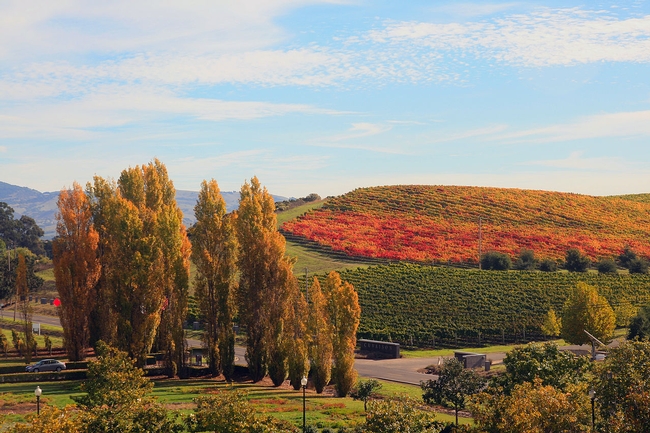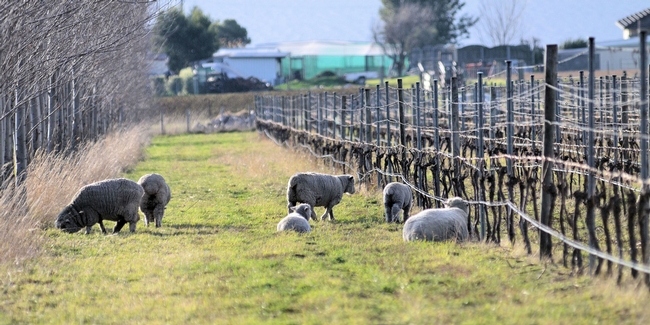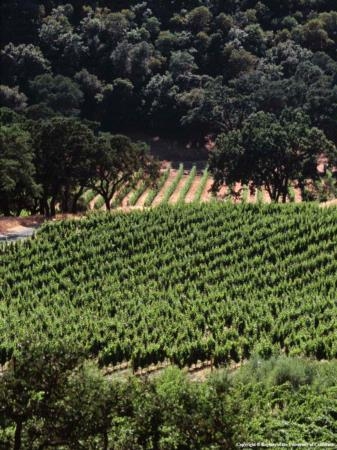Posts Tagged: wine
The Feast: A Celebration With Mead and Honey
Soon the quince and almonds will burst into bloom. Soon the honey bees will be buzzing all over them. And soon will be the third annual "The Feast:...
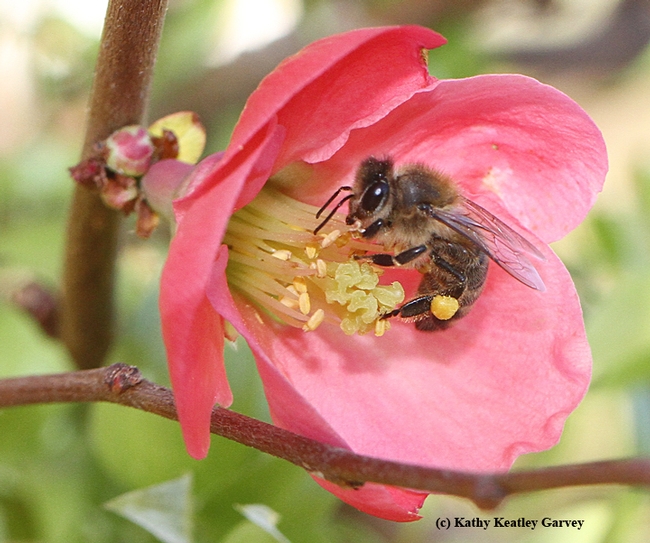
A honey bee foraging on a flowering quince on Jan. 21, 2015. Photo by Kathy Keatley Garvey)
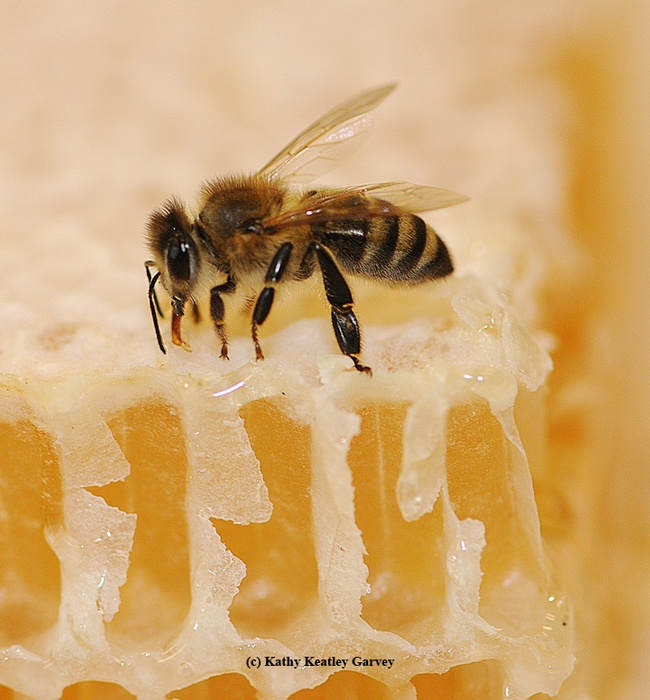
A honey bee on a honey comb. (Photo by Kathy Keatley Garvey)
Fall colors in wine country are not a picture of health
The glorious fall colors in California wine country aren't good news for the industry. Although they look beautiful in the muted autumn sunlight, red leaves on grapevines can be a symptom of serious plant diseases, such as grape leafroll associated viruses and red blotch.
In 2008, a disease characterized by red blotches along leaf margins and red veins under the leaf surfaces was seen in red grapes growing in Napa Valley. The symptoms resembled leafroll disease, however laboratory tests did not detect any leafroll and rugose wood viruses in the samples. Since then, red blotch disease has been observed in vineyards throughout North America.
The infected grapevines may produce clusters with reduced sugar content, causing delayed harvests. Poor color development and increased acidity are found in some clusters on diseased vines.
A virus associated with red blotch disease was identified in 2012. The incidence of the red blotch disease relative to other virus diseases is currently not known, according to the UC IPM Pest Management Guidelines. The guidelines, produced by UC Agriculture and Natural Resources' (UC ANR) Statewide Integrated Pest Management Project, offer comprehensive information free online for pest control in more than 50 California crops.
UC ANR Cooperative Extension specialist, Deborah Golino, director of Foundation Plant Services at UC Davis, wondered if the virus associated with red blotch disease was new to California. She turned to the UC Davis Herbarium, a repository of 300,000 pressed plant samples, including grapevines dating back to 1940.
Golino and her laboratory staff collected 56 samples and, to prevent contamination, tested them in a lab that only works with lettuce. Of the 56 samples, one, an early burgundy collected in Sonoma County, was positive.
“We have confirmed that red blotch disease is not new,” Golino said. “It's been around at least since 1940.”
The results were published this year by the American Phytopathological Society in the journal Plant Disease.
An initiative to manage endemic and invasive pests and diseases is part of UC Agriculture and Natural Resources Strategic Vision 2025.
On the topic of vineyard nutrient management, farmers want to know about sheep
The UC Sustainable Agriculture Research and Education Program is working to build an online community for growers facing challenges and trying innovative approaches to how they manage nutrients on the farm. With the help of FarmsReach and Sustainable Conservation, we've been working to build up an online group based on nutrient management to discuss a wide array of practices. For two weeks in January, we hosted a discussion on nutrient management for vineyards, particularly in times of drought.
In a recent Capital Public Radio story on winemakers struggling with groundwater shortages this year, winemaker Chris Leamy said “the drought has helped to spur change and innovation.” When business as usual is not an option, farmers get creative. Through discussion, informational videos, and a tool kit of resources, farmers and UC advisors shared some of the creative ways that growers are adapting to water limitations and building healthy soil in their vineyards.
One discussion to rise to the surface throughout was the use of animals in vineyard systems. Farmers with experience running animals through their vineyards chimed in with valuable insights.
Some thoughts repeated by several growers were:
- Short breeds like babydoll sheep and tall cordons on vines make sheep less able to graze on the canopy. Some growers use electrified deterrents running parallel to the trellis to allow sheep to stay in the vineyard into the summer with no leaf damage. Growers who kept sheep in vineyards year round described eliminating mowing completely.
- Drip lines need to be tall enough to be out of reach from sheep.
- Move sheep frequently to prevent soil compaction.
- One grower runs chickens through the vineyard at the end of the season, but says to avoid the practice if shoot growth has been too vigorous — the added nutrients from the chickens may give vines an unwanted boost in the spring.
- Growers who use sheep in their vineyards describe significant nutrient inputs from sheep, some to the point of eliminating other fertilizers altogether.
You can follow more of the conversation here. The group of participants is growing (94 strong now!) and we'll be hosting future discussions on different topics. This project is hosted by UC SAREP as part of the Solution Center for Nutrient Management. You can join our mailing list to stay up-to-date with our activities, online discussions, and updates to our website.
Growing wine grapes without irrigation possible for some, not all
"If you don't water in the San Joaquin Valley, you're not getting a yield," Larry Williams, a professor in the Department of Viticulture and Enology at UC Davis and based at Kearney Agricultural Research and Extension Center, told Pierson.
Last month Sacramento Bee columnist Mike Dunne used Williams' study of water use of chardonnay grapes in the Carneros Region to refute the amount of water a Dutch researcher claimed was required to produce a single glass of wine. “In California vineyards and cellars, is 29 gallons of water to produce a single glass of wine a realistic estimate?” Dunne asked Williams, who explained that California grape yields per gallon of water are much higher than in Europe.
“The mean yield of wine grapes in Europe ... is around 1.8 tons per acre using data I've gleaned from research papers,” Williams says. “The mean chardonnay yields across California are 7.4 tons per acre.”
Based on Williams' research, Dunne wrote, “Vines of the dry-farmed portion yielded 4.9 tons per acre, while vines on the irrigated portion produced 6.3 tons per acre. The upshot was that 14.2 gallons of water was needed in the dry-farmed block to produce a typical 4-ounce pour of wine, while 15.3 gallons of water was needed in the irrigated parcel to produce a 4-ounce pour of wine, totals far lower than the figure calculated by the Water Footprint Network.”
Roof-top gardens on LA skyscrapers connect people with food
"Chefs are using what's produced (in the garden) in their kitchens because they know their customers appreciate fresh, local food," said Rachel Surls, the sustainable food systems advisor for UC Cooperative Extension in Los Angeles County.
Surls was part of a recent tour of urban agriculture in downtown Los Angeles, a story that was also covered by the LA Times.
The visitors — who included growers, urban policymakers, consultants, entrepreneurs and representatives of nonprofits — wandered around the vegetable beds and asked questions as they got a taste of the garden. The article said the garden, on the fifth floor of a building at 6th and Figueroa streets, cost about $40,000 to build and yields as much as $150,000 worth of produce every year.
Other news:
Drought clouds future of California wine industry
W. Blake Gray, Wine-searcher-com
The California drought didn't impact the wine industry in 2014, but a dry forecast for next year has growers worried. One major issue is the buildup of salts in soils, said Mark Battany, UC Cooperative farm advisor in San Luis Obispo County. During a wet winter, these salts are washed away. But California hasn't had a wet winter in three years. Farmers were able to irrigate at the beginning of the drought to make up the difference, but increasingly water supplies are restricted.
Battany says that excess salt buildup in the soil can cause grapevines to lose their leaves. "Without a way to process sunlight, you won't see sugar ripening," he said.
Showdown looms as California eyes pesticides
Ellen Knickmeyer, Associated Press
Organic farmers are challenging a proposed California pest-management program they say enshrines a pesticide-heavy approach for decades to come, including compulsory spraying of organic crops at the state's discretion.
The farmers are concerned about the California Department of Food and Agriculture's pest-management plan, the article says. The 500-page document lays out its planned responses to the next wave of fruit flies, weevils, beetles, fungus or blight that threatens crops. Many groups challenging the plan complained that it seems to authorize state agriculture officials to launch pesticide treatments without first carrying out the currently standard separate environmental-impact review.
The article reported that the California organic agriculture industry grew by 54 percent between 2009 and 2012. California leads the nation in organic sales, according to statistics tracked by UC Cooperative Extension specialist Karen Klonsky, who says the state is responsible for roughly one-third of a national organic industry.


